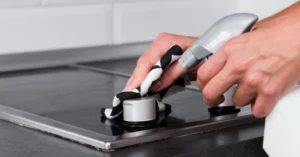A broken oven can throw a wrench in your cooking plans, especially in a foodie city like San Francisco where home-cooked meals are a way of life. Whether you’re prepping sourdough or roasting veggies from the farmers’ market, an oven that won’t heat is a major inconvenience. But don’t worry—this comprehensive guide will walk you through the most common reasons your oven isn’t heating and how to fix it, with practical DIY tips tailored for San Francisco residents.
Why Your Oven Isn’t Heating: Common Culprits
Ovens, whether gas or electric, are complex appliances with multiple components that can fail. Based on extensive research and expert insights, here are the top reasons your oven might not be heating, along with step-by-step troubleshooting tips.
1. Power Supply Issues
Before diving into complex repairs, check the basics. A faulty power supply is often the culprit for an oven that won’t heat.
- For Electric Ovens: Ensure the oven is plugged into a functioning outlet. San Francisco homes, especially older ones in neighborhoods like Mission or Noe Valley, may have outdated wiring or tripped breakers. Check your circuit breaker panel (usually in the basement or garage) to see if the oven’s breaker has tripped. Reset it if needed. Most electric ovens require 240 volts, so test the outlet with a multimeter to confirm it’s delivering adequate power.
- For Gas Ovens: Verify the gas valve is open. In San Francisco, where gas appliances are common, check if other gas appliances (like stovetop burners) are working. If they aren’t, the issue might be with the gas supply, requiring a call to PG&E or a licensed technician.
Fix: Reset the breaker, replace a blown fuse, or contact your utility provider if the gas supply is interrupted.
2. Faulty Heating Elements (Electric Ovens)
The bake and broil elements are the heart of an electric oven’s heating system. If either is damaged, your oven won’t heat properly.
- Signs of a Faulty Element: Look for visible damage like cracks, blisters, or breaks. Turn the oven on and check if the element glows red. If it stays cold, it’s likely broken.
- Testing: Unplug the oven, remove the element by unscrewing it, and test for continuity with a multimeter. A reading between 19–115 ohms indicates a working element; no continuity means it’s faulty.
Fix: Replacement elements cost $20–$50 and are relatively easy to swap out. Purchase a compatible part from a local appliance store in San Francisco, like Spencer’s TV & Appliance, and follow the manufacturer’s instructions to install it.
3. Malfunctioning Igniter (Gas Ovens)
Gas ovens rely on an igniter to spark the gas and create heat. A weak or broken igniter is a common reason for a cold oven.
- Signs of a Faulty Igniter: When you turn on the oven, listen for clicking sounds followed by a “whoosh” of gas igniting. If the igniter glows dimly or not at all, it’s likely failing to open the safety valve.
- Testing: Access the igniter (usually in the broiler drawer) and check for cracks or damage. Use a multimeter to test for continuity.
Fix: Replacing an igniter requires a compatible model for your oven brand (e.g., Whirlpool, Maytag). This DIY repair takes about 30 minutes but involves working near gas lines, so proceed cautiously or hire a pro.
4. Broken Temperature Sensor
The temperature sensor regulates the oven’s internal temperature by communicating with the control board. If it’s faulty, the oven may not heat or may overheat.
- Signs of a Faulty Sensor: Uneven cooking, error codes on the display, or the oven not reaching the set temperature. In San Francisco’s cooler climate, temperature fluctuations can exacerbate sensor issues.
- Testing: Locate the sensor (a thin probe on the oven’s back wall) and ensure it’s not touching the oven wall. Use a multimeter to check resistance, which should increase with temperature (consult your manual for specific readings).
Fix: A new sensor costs $20–$40 and can be replaced with basic tools. Follow a YouTube tutorial for your oven model to avoid damaging nearby components.
5. Blown Thermal Fuse
Electric ovens have a thermal fuse to prevent overheating. If it blows due to a power surge or short circuit, the oven won’t heat.
- Signs of a Blown Fuse: The oven is completely dead, or the display is dark despite power.
- Testing: Locate the fuse (check your manual) and test for continuity with a multimeter. No continuity means it’s blown.
Fix: Replace the fuse with an identical rating (available at hardware stores like Cole Hardware in San Francisco). Address the underlying cause (e.g., wiring issues) to prevent recurrence.
6. Faulty Control Board
The electronic control board acts as the oven’s brain, directing power to heating elements or the igniter. Power surges, common in San Francisco during stormy winters, can damage it.
- Signs of a Faulty Board: The oven powers on but doesn’t heat, or the display shows error codes.
- Testing: Testing a control board is complex and often requires professional diagnostics.
Fix: Replacing a control board is expensive ($100–$300) and tricky. If other components check out, consult a technician before investing in a new board.
7. Thermostat or Calibration Issues
Older ovens use a thermostat to control temperature, which can fail or become miscalibrated over time.
- Signs of a Faulty Thermostat: The oven doesn’t reach the set temperature, or food cooks unevenly.
- Testing: Use an oven thermometer to verify the internal temperature. If it’s off by more than 25°F, recalibration may be needed.
Fix: Refer to your manual for calibration instructions, typically involving an adjustment screw. If the thermostat is broken, replacement is best left to professionals due to high-voltage risks.
When to Call a Professional
While many oven issues are DIY-friendly, some require expert intervention to ensure safety and compliance with San Francisco’s strict building codes. Call a professional if:
- Gas Leaks Are Suspected: If you smell gas or suspect a leak, evacuate and call PG&E or a licensed technician immediately.
- Electrical Hazards: High-voltage components like control boards or wiring pose shock risks. A certified electrician or appliance repair specialist is safer.
- Complex Repairs: Replacing a control board, safety valve, or thermostat involves intricate wiring or gas line work.
- Warranty Concerns: For newer ovens, DIY repairs may void the warranty. Check with your manufacturer or retailer.
- Persistent Issues: If troubleshooting doesn’t resolve the problem, a professional can diagnose deeper issues like faulty relays or gas valves.
Contact our expert oven repair team for fast, reliable oven repair tailored to Bay Area homes.
Safety Tips for DIY Oven Repairs
Before attempting any repair:
- Disconnect Power: Unplug the oven or turn off the breaker to avoid electric shock.
- Shut Off Gas: For gas ovens, close the gas valve to prevent leaks.
- Use Proper Tools: A multimeter, screwdriver, and socket wrench are essential for safe repairs.
- Consult the Manual: Your oven’s manual provides model-specific guidance.
- Know Your Limits: If you’re unsure, stop and call a professional to avoid costly damage or injury.
FAQs: Fixing an Oven That Won’t Heat
1. How do I know if my oven’s heating element is broken?
Look for cracks, blisters, or breaks on the element. Turn the oven on; if it doesn’t glow red, test it with a multimeter for continuity.
2. Why is my oven on but not heating?
Common causes include a faulty heating element, igniter, temperature sensor, or blown thermal fuse. Check each component systematically.
3. How much does it cost to replace an oven heating element?
A new heating element costs $20–$50, with DIY installation. Professional replacement in San Francisco may cost $100–$200, including labor.
4. Can I replace an oven element myself?
Yes, if you’re comfortable with basic tools and safety precautions. Unplug the oven, remove the old element, and install a compatible replacement.
5. How do I reset my oven?
Unplug the oven or turn off the breaker for 5–10 minutes to reset the control board. Check the manual for model-specific reset instructions.
6. Why is my gas oven not heating, but the stovetop works?
The igniter or safety valve is likely faulty, preventing gas from igniting in the oven. Test the igniter with a multimeter or call a technician.
7. Is it cheaper to repair or replace an oven?
Repairs costing less than 50% of a new oven’s price (around $500–$1,000 in San Francisco) are usually worthwhile. For older ovens with frequent issues, replacement may be more cost-effective.
Conclusion: Get Your Oven Cooking Again
A non-heating oven doesn’t have to derail your culinary adventures in San Francisco. By systematically troubleshooting power issues, heating elements, igniters, sensors, or fuses, you can often fix the problem yourself. For complex or hazardous repairs, don’t hesitate to call a professional to restore your oven’s performance safely. With these tips, you’ll be back to baking, roasting, and enjoying home-cooked meals in no time.
For expert oven repair in the Bay Area, Call us or schedule a service today!





